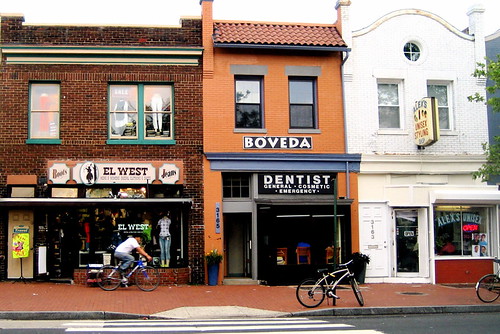HCWDC Intern Ashley Portillo Reports on a Remarkable Performance
Standing in front of a sold-out crowd on a Sunday night, Quique Aviles did something I have never seen done in my life. He
performed a history lesson pouring out poetry from his heart and soul, acted out five “characters,” and infused his show with history – all the while, using musical cues to shift the show from one decade to the next. His compelling one-man performance called
Los Treinta is the result of months of oral history research and a lifetime of personal experience. The project, directed by B. Stanley of the DC Community Arts Center was funded, in part, by the Humanities Council of Washington, DC.
Quique performed his bilingual show as if there were seven actors and a translator - but there was just Quique, on the stage by himself. In the corner, one light beam shining down on him, he flows through poetry, narration, drama and music. At center-stage he played the role of a
pupusera, an older woman he interviewed so he could share her story. Quique is always interpreting. Interpreting every monologue from Spanish to English and at times infusing both languages. His command of the spoken word in Spanish and English was solid and powerful even for the non-Spanish speakers in the diverse audience. But let me be clear: he did not translate his monologues; he interpreted them - a much harder task, but one which he did with great success. He interpreted the stories of those who directly experienced the changes that occurred in DC when many Salvadorans found refuge here in 1980.
Then there was the story of the young American man who had to help his Salvadoran mother sell salsa music cassette tapes at a local market’s parking lot. He didn’t understand the popularity behind those sappy love songs nor did he care for the “stupid lyrics” about
el gato volador (the flying cat) or
la vaca, la misma vaca (the cow, the same cow). He just knew those cassettes were selling like hot buns out of the oven in his Salvadoran community.
Finally, Aviles performed the story of another oral history narrator named Jumbo. This person wasn’t Salvadoran or Salvadoran-American; he was African. Aviles acted out Jumbo’s persona and told the story of a couple that believed love has no color. Jumbo, an immigrant from Africa, married his Salvadoran girlfriend and they had children together at a time when tensions between blacks and latinos ran high in DC. The constant clash between the two groups has significantly died down and Aviles wanted to ensure his performance included a piece from an outside perspective.
Upon arriving at the District of Columbia Arts Center, I was not sure what to expect. Yet, what I witnessed that evening was a compelling, and at times humorous, series of vignettes on the history of El Salvadoran migration to our nation’s capital, spanning the 30 years (Los Treinta) between 1980 and the present. Most in the audience were anxious to hear why so many from El Salvador chose DC as their destination of choice in the United States, but by the end of the performance the answer was seemingly even more elusive despite the simplicity of the apparent motives. During the question and answer period following the show, a woman asked Aviles to clarify why this massive influx of
guanacos came to Washington, DC. She was still unsure, and frankly, so was I. A Salvadoran immigrant from the audience fielded the question stating that word-of-mouth was the primary reason. When a few people fled to D.C. because of the United States backed military violence in El Salvador, she added, they sent financial remittances to their families in El Salvador; others quickly followed suit and soon everyone was immigrating to D.C.
Quique agreed with this version of events. In fact, according to his performance,
la pupusera left for DC to reunite with her mother who had already settled there to create a better life for her family. Soon, she founded her own catering business tailored for her Salvadoran community, and earned enough money to bring her children from El Salvador. Those Salvadoran-born children, but American-raised adults, then started their own families - American families.
As the lights came back on and Marc Anthony’s
I Need to Know played in the background, I could not keep myself from smiling. In just one hour and fifteen minutes, I connected with real people I do not even know, but who I felt I understood. Quique Aviles- the poet, artist, interpreter, story-teller, and activist who tirelessly conducted extensive oral histories with the help of University of Maryland students gave us an illuminated glimpse at that research. In doing so, he also shed light on a slice of Latino history, integral to understanding Washington, DC.
(Above Image:
Quique Aviles promotes Los Treinta on Youtube.)





















